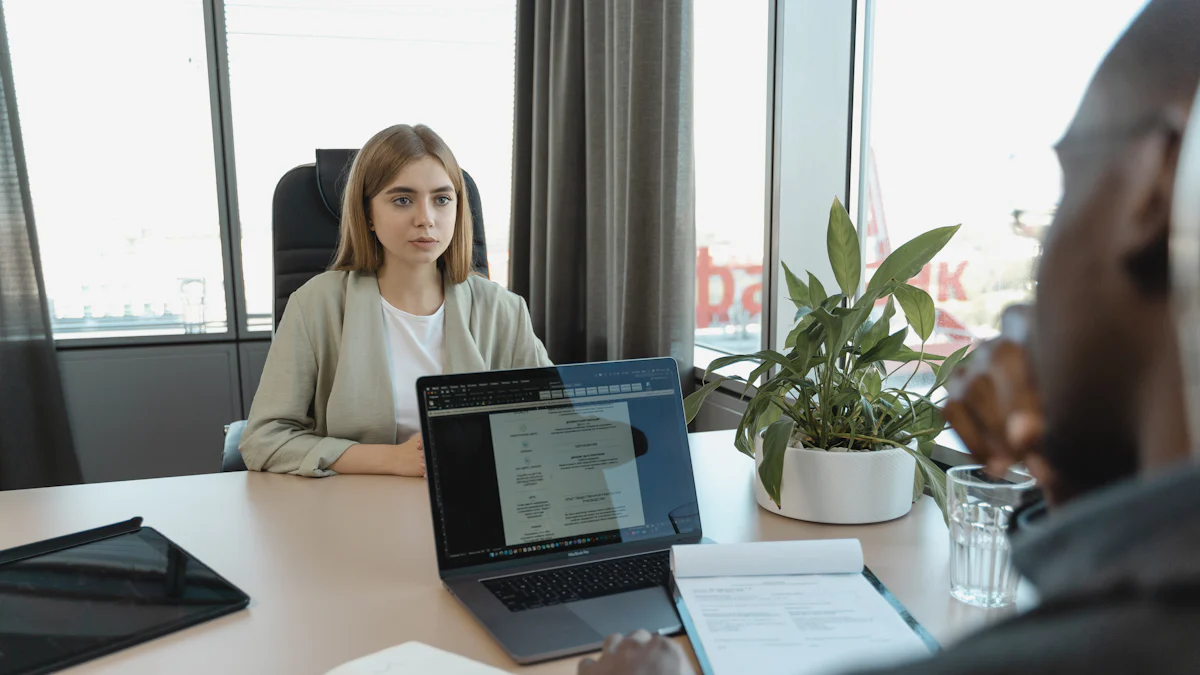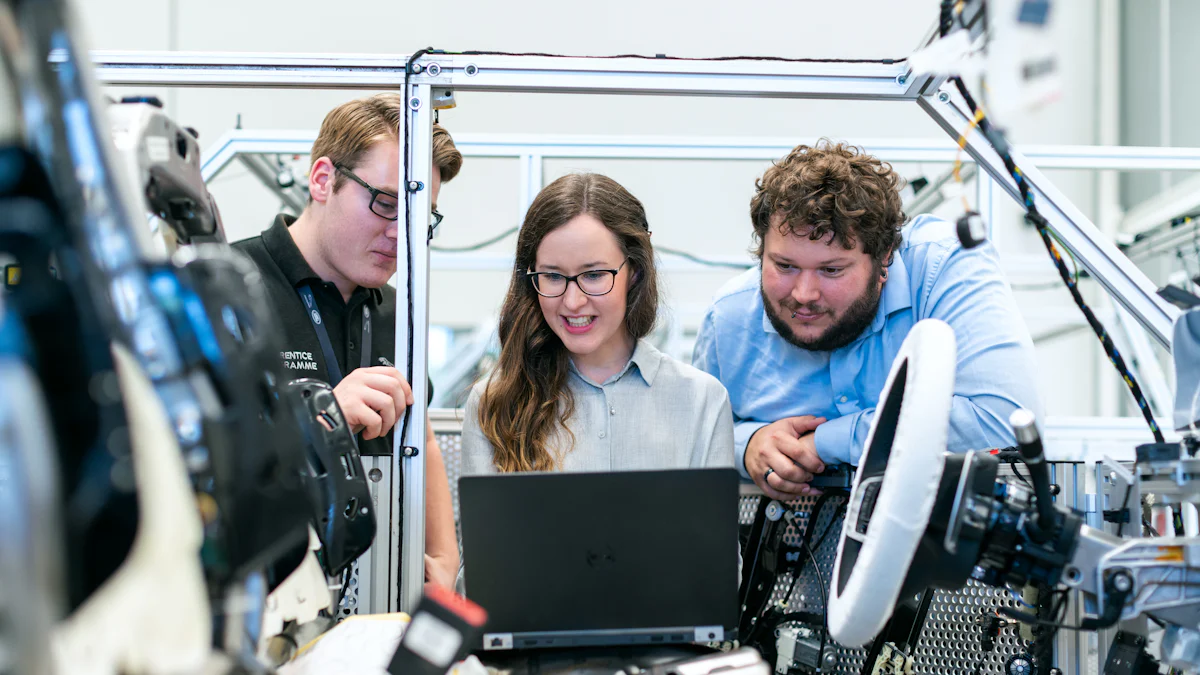How to Ace a PDM Engineer Interview at Quanta Manufacturing
Try Aihirely for
Smarter Interview Prep
Experience real-time AI support tailored to your Resume.
Boost your confidence and ace every question with
AI Mock Interview.

Image Source: pexels
Preparing for a PDM Engineer Quanta Manufacturing interview might seem daunting, but it doesn’t have to be. Success depends on thorough preparation. It’s essential to familiarize yourself with the interview process, highlight your technical expertise, and practice delivering confident responses. During the PDM Engineer Quanta Manufacturing interview, employers will evaluate your problem-solving skills and assess how well you align with their team dynamics. By investing time in preparation, you’ll approach the interview with confidence, ready to impress and secure the position.
Key Takeaways
-
Learn about the interview steps. Know the stages: phone call, technical test, and group interview. Each step checks different abilities.
-
Get ready for technical and behavior questions. Study PDM tools, CAD software, and use the STAR method to answer behavior questions.
-
Show your skills and problem-solving ability. Talk about past work and how it fits the PDM Engineer job.
-
Improve how you explain ideas. Practice sharing technical ideas simply so everyone understands.
-
Try practice interviews. Pretend it’s a real interview to gain confidence and ask for tips to do better.
What to Expect in a PDM Engineer Quanta Manufacturing Interview
Interview Stages
Overview of the interview process
When you step into a PDM engineer Quanta Manufacturing interview, you’ll encounter a structured process designed to evaluate your skills and fit for the role. Typically, the journey begins with a phone screening. This stage focuses on your background, experience, and understanding of PDM systems. If you pass this, you’ll move on to a technical interview. Here, you’ll tackle questions about engineering principles, CAD tools, and problem-solving scenarios. Finally, there’s often a panel interview. This stage involves multiple team members assessing your technical expertise and how well you align with the company’s culture.
Duration and structure of each stage
Each stage varies in length. The phone screening usually lasts 20-30 minutes. The technical interview can take up to an hour, depending on the complexity of the questions. The panel interview is often the most comprehensive, lasting 60-90 minutes. During this time, you’ll answer both technical and behavioral questions. Be prepared to discuss your past projects and how they relate to the PDM engineer role.
Types of Questions
Technical questions on PDM systems, CAD tools, and engineering principles
Expect technical questions that test your knowledge of PDM systems and PLM software. You might be asked to explain how you’ve used CAD tools in previous roles or how you’ve managed data within a PDM system. Questions could also dive into engineering workflows and manufacturing processes. Brush up on these areas to showcase your expertise.
Behavioral questions to assess teamwork, adaptability, and problem-solving
Behavioral questions are just as important. You might be asked to describe a time when you resolved a conflict within a team or adapted to a challenging situation. Use specific examples to highlight your problem-solving skills and ability to work collaboratively.
Evaluation Criteria
Focus on technical expertise and problem-solving abilities
Quanta Manufacturing places a strong emphasis on technical expertise. They’ll evaluate your ability to troubleshoot issues, manage data, and apply engineering principles effectively. Your problem-solving skills will also be under the spotlight, so be ready to demonstrate how you approach complex challenges.
Importance of communication skills and cultural fit
Your communication skills matter just as much as your technical abilities. You’ll need to explain technical concepts clearly, especially to non-technical team members. Additionally, Quanta Manufacturing values cultural fit. They’ll assess how well your values align with their mission and how you’ll contribute to their team dynamics.
Key Skills and Traits for a PDM Engineer at Quanta Manufacturing

Image Source: pexels
Technical Proficiency
Expertise in PDM systems and PLM software
To excel as a PDM engineer, you need a strong grasp of PDM systems and PLM software. These tools are the backbone of managing product data and workflows. At Quanta Manufacturing, you’ll likely work with CAD data, so experience with tools like Solidworks is a big plus. You should also know how to manage CAD data within a PDM system. This ensures smooth collaboration and efficient data handling across teams.
Here’s a quick look at the technical skills you’ll need:
| Skill/Requirement | Description |
|---|---|
| Design Engineer (Solidworks) | Work independently on weldments, sheet metal designs, modeling, and detailing using Solidworks. |
| Experience in Industrial Products | Experience with large industrial products, especially in oil & gas, is advantageous. |
| Knowledge of Fabrication Processes | Understanding fabrication processes and weldments is essential. |
| PDM Tool Experience | Hands-on experience with any PDM tool is required. |
| CAD Data Management | Ability to manage CAD data in the PDM system. |
| Skills Required | Design, Solidworks, Mechanical, Sheet metal. |
Understanding of manufacturing processes and engineering workflows
You’ll need to understand how manufacturing processes work. This includes knowing how engineering workflows connect with production. For example, you might need to optimize data flow between design and production teams. This ensures that projects move smoothly from concept to completion.
Problem-Solving and Critical Thinking
Analytical skills for troubleshooting and data management
As a PDM engineer, you’ll face challenges that require sharp analytical skills. Whether it’s troubleshooting a data issue or optimizing a workflow, you’ll need to think critically. For instance, integrating different technology modules into a single solution can be tricky. Compatibility issues between components often arise, and you’ll need to find creative ways to resolve them.
Ability to address complex engineering challenges
Complex engineering problems are part of the job. You might encounter situations like mismatched data models between hardware and machine-learning algorithms. Or, you could work on developing cost-effective solutions that require collaboration with multiple vendors. These challenges demand a mix of technical knowledge and innovative thinking.
Communication and Teamwork
Explaining technical concepts to diverse audiences
You’ll often need to explain technical ideas to people who don’t have an engineering background. This could include team members from marketing or sales. Clear communication helps everyone stay on the same page and ensures project success.
Collaborating effectively with cross-functional teams
Teamwork is key at Quanta Manufacturing. You’ll work with designers, engineers, and production teams. Strong collaboration skills help you build trust and ensure that everyone works toward the same goal. Whether it’s solving a problem or launching a new product, teamwork makes the process smoother.
How to Prepare for a PDM Engineer Quanta Manufacturing Interview

Image Source: pexels
Research Quanta Manufacturing
Learn about the company’s mission, values, and products
Start by diving into Quanta Manufacturing’s mission and values. Understanding what drives the company helps you align your answers with their goals. Look into their product lines and how they contribute to the industry. For example, if they specialize in innovative manufacturing solutions, think about how your skills can support that mission. This knowledge shows you’re genuinely interested in the role and the company.
Study recent projects and innovations
Take time to explore Quanta Manufacturing’s recent projects. Have they launched a groundbreaking product? Are they using cutting-edge technology in their processes? Knowing these details can help you connect your experience to their work. Mentioning specific projects during the interview demonstrates your enthusiasm and preparation.
Prepare for Technical Assessments
Review PDM concepts, tools, and best practices
Brush up on your knowledge of PDM systems and tools. Revisit key concepts like data management, version control, and workflow optimization. Familiarize yourself with the software they might use, such as Solidworks or other PLM tools. This preparation ensures you’re ready to tackle technical questions confidently.
Practice solving engineering problems and case studies
Practice makes perfect. Work through engineering problems and case studies to sharpen your problem-solving skills. Focus on scenarios that involve PDM systems or manufacturing workflows. This will help you feel more comfortable when faced with similar challenges during the interview.
Practice Behavioral Responses
Use the STAR method to structure answers
Behavioral questions can be tricky, but the STAR method makes them easier to handle. Here’s how it works:
| Component | Description |
|---|---|
| Situation/Task | Explain the situation or task so others understand the context. |
| Action | Give details about what you or another person did to handle the situation. |
| Result | Describe what was achieved by the action and why it was effective. |
Using this structure keeps your answers clear and focused. It also helps you highlight your problem-solving and teamwork skills effectively.
Reflect on past experiences that demonstrate key skills
Think about your previous roles and projects. Identify moments where you showcased skills like adaptability, collaboration, or technical expertise. These examples will come in handy when answering behavioral questions. Be ready to explain how those experiences prepared you for the challenges of a pdm engineer quanta manufacturing interview.
Enhance Communication Skills
Practice explaining technical ideas clearly and concisely
Clear communication is a game-changer in any interview, especially for a PDM Engineer role. You’ll need to explain complex technical concepts in a way that anyone can understand, even if they don’t have an engineering background. Think of it like telling a story. Start with the big picture, then break it down into smaller, digestible parts.
Here’s a tip: practice simplifying technical jargon. For example, instead of saying, “I optimized the CAD data management workflow,” you could say, “I made it easier for teams to access and share design files.” This approach makes your ideas relatable and easy to follow.
You can also use analogies to make your points stick. Let’s say you’re explaining how a PDM system works. You might compare it to a library where every book (or file) has a specific place, making it easy to find and track. Analogies like this show you can adapt your communication to different audiences.
Conduct mock interviews to refine delivery
Mock interviews are your secret weapon for improving communication. They help you practice answering questions under pressure and refine how you deliver your responses. Ask a friend, mentor, or even a colleague to play the role of the interviewer.
Record these sessions if possible. Watching yourself later can reveal areas where you might need improvement, like pacing or tone. Are you speaking too fast? Are your answers too long? Adjust accordingly.
You can also focus on your body language. Sit up straight, maintain eye contact, and use hand gestures naturally. These small details can make you appear more confident and engaged.
Pro Tip: Treat mock interviews like the real thing. Wear professional attire and set up a quiet space. This will help you feel more prepared when the actual interview day arrives.
Tips for Success in a PDM Engineer Quanta Manufacturing Interview
Conduct Mock Interviews
Simulate the interview environment to build confidence
Mock interviews are a fantastic way to prepare. Set up a quiet space, dress professionally, and treat it like the real deal. This helps you get comfortable with the interview format and reduces nerves. Simulating the environment also lets you practice answering questions under pressure, so you’ll feel more confident on the big day.
Seek feedback to improve responses
Feedback is gold when it comes to mock interviews. Ask your mock interviewer to provide constructive and actionable suggestions. For example, they might point out areas where you can improve your storytelling or clarify your technical explanations. Pay attention to both verbal and non-verbal cues, like your tone or body language. After the session, jot down the feedback immediately while it’s fresh. Use it to refine your responses and practice again. Remember, the goal is growth, not perfection.
Review Your Portfolio
Be prepared to discuss past projects and achievements
Your portfolio is your chance to shine. Go through your past projects and pick a few that highlight your skills as a PDM engineer. Be ready to explain your role, the challenges you faced, and the results you achieved. For example, if you optimized a PDM system to improve workflow efficiency, share the details. Numbers and measurable outcomes make your achievements even more impressive.
Highlight experiences relevant to the PDM Engineer role
Focus on experiences that align with the job requirements. If you’ve worked with CAD tools or managed data in a PDM system, make sure to emphasize those. Tailoring your portfolio to the role shows you understand what Quanta Manufacturing is looking for. It also makes it easier for the interviewers to see how you’ll contribute to their team.
Stay Positive and Confident
Approach challenges with a problem-solving mindset
Interviews can be unpredictable, but staying calm and focused makes a big difference. Treat every question as an opportunity to showcase your problem-solving skills. If you’re asked about a tricky situation, explain how you approached it and what you learned. This shows you’re adaptable and resourceful.
Focus on your strengths and unique qualifications
Confidence comes from knowing your worth. Think about what makes you stand out. Maybe it’s your expertise with PDM systems or your ability to collaborate with cross-functional teams. Highlight these strengths during the interview. When you focus on what you bring to the table, it’s easier to stay positive and make a lasting impression.
Pro Tip: Smile and maintain eye contact during the interview. It helps you come across as approachable and confident.
Preparing for a PDM Engineer interview at Quanta Manufacturing doesn’t have to feel overwhelming. By following the steps outlined here, you’ll set yourself up for success. Research the company, sharpen your technical skills, and practice answering questions confidently.
Remember: Preparation is your secret weapon. The more you practice, the more natural and confident you’ll feel during the interview.
Approach the process with a positive mindset. Highlight your unique skills and show how you’re the perfect fit for the role. You’ve got this! 🚀
FAQ
What should I wear to the interview?
Dress professionally to make a great first impression. A business casual outfit works well unless the recruiter specifies otherwise. Think of a clean shirt, slacks, or a blazer. Avoid overly casual attire like jeans or sneakers. Looking polished shows you’re serious about the role.
How can I stand out during the interview?
Show enthusiasm for the role and the company. Share specific examples of your achievements that align with the job. Ask thoughtful questions about the team or projects. Confidence and preparation will make you memorable.
What if I don’t know the answer to a technical question?
Stay calm and honest. Let the interviewer know how you’d approach finding the solution. For example, mention resources you’d use or steps you’d take. This shows problem-solving skills and a willingness to learn.
How do I prepare for behavioral questions?
Use the STAR method (Situation, Task, Action, Result) to structure your answers. Reflect on past experiences that highlight your teamwork, adaptability, or problem-solving skills. Practice explaining these stories clearly and concisely.
Should I follow up after the interview?
Yes! Send a thank-you email within 24 hours. Mention something specific from the interview to show your engagement. A polite follow-up reinforces your interest in the role and keeps you on the interviewer’s radar.
Pro Tip: Keep your follow-up short and professional.
